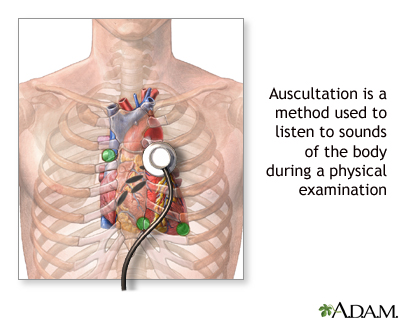Auscultation
Auscultation is listening to the sounds of the body during a physical examination .
Physical examination
During a physical examination, a health care provider studies your body to determine if you do or do not have a physical problem. A physical examinat...
Information
Auscultation is usually done using a tool called a stethoscope. Health care providers routinely listen to a person's lungs, heart, and intestines to evaluate these things about the sounds:
- Frequency
- Intensity
- Duration
- Number
- Quality
Providers also use auscultation to listen to the heart sounds of unborn infants. This can be done with a stethoscope or with sound waves (called Doppler ultrasound).
Auscultation can also be used to hear pulses in the arms and legs.
References
Dorland's Online Medical Dictionary. Available at: www.dorlands.com/def.jsp?id=100010441 . Accessed June 1, 2015.
Goldman L. Approach to the patient with possible cardiovascular disease. In: Goldman L, Schafer AI, eds. Goldman-Cecil Medicine . 25th ed. Philadelphia, PA: Elsevier Saunders; 2015:chap 51.
-
Auscultation - illustration
Auscultation is a method used to listen to the sounds of the body during a physical examination by using a stethoscope. A patient's lungs, heart, and intestines are the most common organs heard during auscultation.
Auscultation
illustration
Review Date: 4/30/2015
Reviewed By: Laura J. Martin, MD, MPH, ABIM Board Certified in Internal Medicine and Hospice and Palliative Medicine, Atlanta, GA. Also reviewed by David Zieve, MD, MHA, Isla Ogilvie, PhD, and the A.D.A.M. Editorial team.


